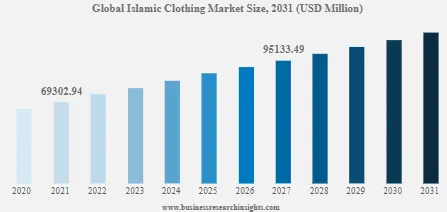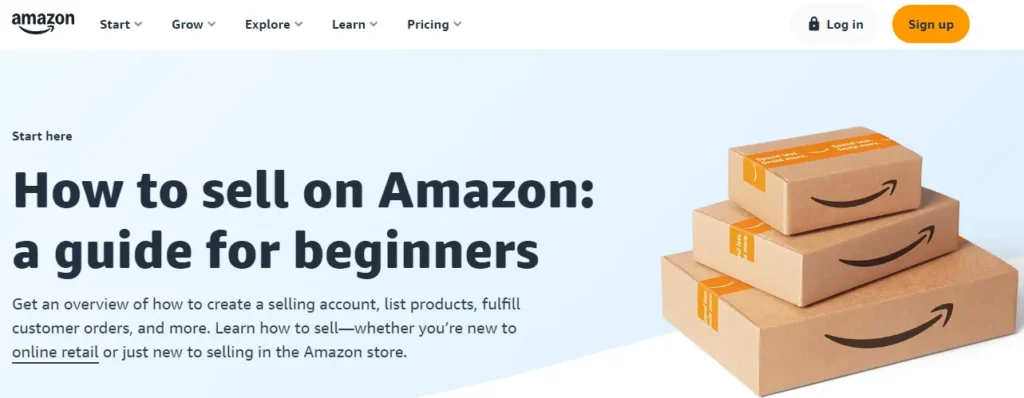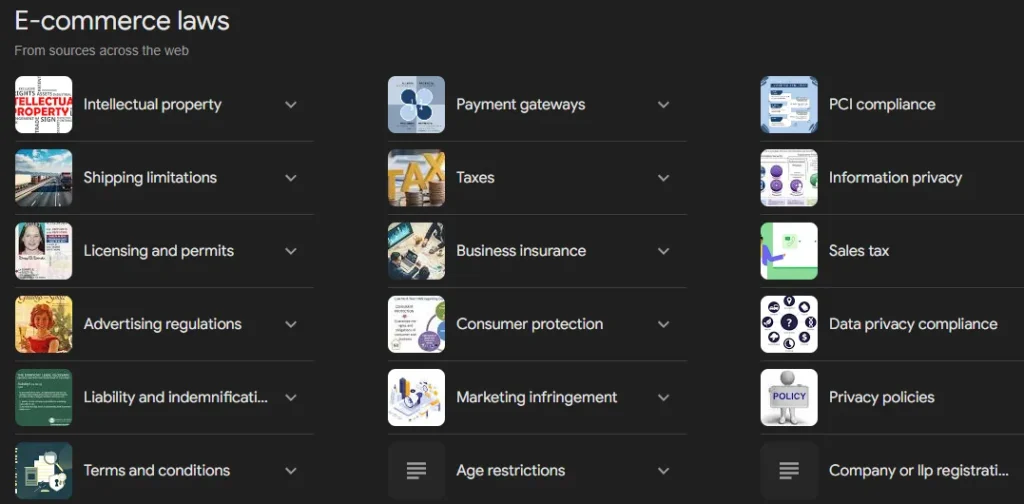Are you looking for a free guide on starting a hijab business and making a profit from it? you’re in the right place. We are here to guide you through the simple steps.
The fashion industry and the Islamic clothing market not only deal with the hijab, but you can find many types of other clothing items for sale such as abaya, jibab, thobe, burka, niqab, khimar, etc.
Having some knowledge, experience, and expertise in this industry can make your journey easier, still, if you are a beginner, there is a great scope to make a profit.
Focus on learning, exploration, and research, and building the foundation.
So, follow the steps to explore the whole process.
Hijab business descripiption
With the growing demand for Islamic clothing and fashion, starting a hijab business can make a great living. Understanding your target customer base creates products that fulfill their needs.
According to Business Research Insights industry analysis, the global Islamic clothing market size was 69.3 billion in 2021, and with a 5.42% CAGR, it is expected to reach USD 95.13 billion by 2027.

The hijab is the popular fashion clothing for Muslim women, mostly worn for religious or personal reasons. Many women are also interested in the latest hijab trends and designs.
With the growing number of Muslims around the world, the demand for hijab has increased with time.
The hijab is not only a clothing product, it has become a cultural identity of Muslim women around the world, and the demand for those products in the market is increasing.
Only knowing the idea and basic process is not enough, executing the idea requires proper planning, research, and understanding the market demand.
Is The Hijab Business Profitable?
Before diving into this idea, you must have doubts about “Is the hijab business profitable?”, because when anybody starts an entrepreneurship journey, first they think about its profitability.
So in the hijab business scenario or any other idea, many factors depend, such as market demand, competition, market saturation, competitive landscape, and potential challenges.
Here are some positive points:
- Growing demand for hijabs
- Large and underserved market
- High-profit margins
- Low startup costs
- Growing online purchase
By focusing on product quality, pricing strategy, operational efficiency, and marketing efforts, you can increase the profit margin and overall profitability of your hijab business.
The hijab is a clothing product and a growing industry.
It is experiencing a Compound Annual Growth Rate (CAGR) of 5.42%, and the global Islamic clothing market is predominantly growing annually due to its demand.
This can create a profitable opportunity for new enthusiasts and provide useful insights into its profitability, ensuring that it is also a competitive industry.
Pros and Cons of Hijab business:
Carefully research, and analyze the pros & cons, as well as learn about the clothing industry.
Pros
- Large market
- High-profit potential
- Low startup costs
- Customization options
- Online sales
- Niche opportunities
Cons
- High competition
- Seasonal sales
- Cultural sensitivity
- Supply chain challenges
- Fashion trends
- Economic risks
- Inventory management
Your passion, hard work, planning, research, and a strong mindset lead to becoming successful, have to develop a growth plan with a growth mindset.
How to start a hijab business? 9 Steps

Conduct market research
Market research is the key to understanding the market in a better way, also it is a vital part of analyzing customer preferences, needs, and current market trends.
Before starting the hijab business, finding your target audience, product research, competitive analysis, industry analysis, and understanding customer intent is important.
Product research:
Start analyzing the market and hijab products online, some important points you can consider (such as designs, sizes, styles, product types, different varieties of Hijabs, pricing, etc).
- Hijab styles: square hijab, triagular hijab, al-amira hijab, shayla hijab, khimar hijab, etc.
- Hijab sizes: depending on the style, focus on various sizes to create products for customers.
- Quality: it depends on the material selection, way of production, and finishing.
- Design: prints, embroidery, sublimation, and even custom designs.
Understanding those factors, plan to create unique designs, to differentiate your brand from others.
Another part is: identifying your niche, target audience, and target market.
Product research is important for developing the best hijab. Also conducting an in-depth analysis of specific segments, niches, and target audiences, helps to create a highly targeted product.
Choose a niche: A niche is a specific segment of the market, for example:
- Style: Luxury hijabs, casual, sports, and evening wear hijabs.
- Material: Silk, cotton, chiffon, jersey hijabs, etc.
- Age: Young adults, mature women, teenagers
- Occasion: Everyday wear, special occasions, workwear
- Religion: Mainly Muslim or Islamic religion.
When you create a product, to reach a specific group of consumers, here is an idea:
Example:
- Niche: Luxury evening wear cotton hijabs
- Target audience: Muslim women aged 25-45, with disposable income and living in urban areas.
- Buying intent: Buying for regular wearing.
For conducting market research: follow some useful sources (online or offline)
Online resources:
- Social media platforms: To explore hijab-related hashtags, trends, influencers, and customer intent and to understand the customer needs social media is the easiest way (Instagram, Facebook, TikTok, etc).
- Market research platforms: Google Trends (for checking search trends), Statista (to learn or access market data and industry reports), and SimilarWeb (useful for analyzing brand website traffic or demographics).
- Online forums: Connect with online forums and communities to gather insights related to hijab-wearing women. Reddit and Quora are popular platforms.
- E-commerce platforms: From Amazon and Etsy platforms, you can gather data related to product listings, customer reviews, and sales data without visiting fashion stores.
Offline resources:
- Visit local and online stores to observe how products are offered, their pricing model, customer buying behavior, etc.
- To gain more insights related to Muslim lifestyle and fashion, you can attend trade shows or Industry conferences, it is helpful to connect or network with professionals.
- Directly communicate with local customers, to know their demand and interest.
Getting data related to market demand, competition, and the target market, can increase the chances of your success, so don’t forget to conduct an in-depth analysis before starting.
Develop a hijab business plan

Once you have completed your research process, the next step is to create a business plan – focusing on achievable goals. This plan should be based on your research and business objectives.
You can use a sample plan as a starting point, but remember that every project is unique.
Solid planning is key to success. It’s like a road map that guides you through creating your startup. With proper planning, you set yourself up for the best chance of success.
You can find many online resources, templates, and guides for writing a business plan.
Here we mentioned some useful steps for creating a plan.
So, don’t forget to check our given information, on this, we have included the essential points to create a sample business plan for a hijab business. (based on traditional format).
Hijab business plan format/sample:
- Executive Summary: First is the Executive summary, in this summary, you can add essential information about the company, introduce yourself, write a story, and detailed product info.
- Company Name: Hijab Chic
- Owner: [Your Name]
- Address: [Your Address]
- Phone Number: [Your Phone Number]
- Email Address: [Your Email Address]
- Website: [Your Website]
- Goal and Mission: Write about your goals to achieve, why you started, how you differentiate your brand, innovative ideas, and value-added products.
- Your target audience: Target Muslim women, prepare Hijabs to fit all sizes of women, and target demographically, according to their religion and culture.
- Product description: Material type, quality of material, variety of colors, styles, etc.
- Financial plan: Require some funds for setting up the venture from scratch, buying inventory, equipment and materials, marketing, utility, rental costs, manpower, etc.
- Sales and distribution: Write how you plan to sell your hijabs (online, retail stores, wholesale, etc.) and how you will reach your target customers.
- Marketing plan: When creating a marketing plan, focus on competitors’ data, analyze the market, add your marketing expenses and cost, sales channel, and advertising strategy (social media, print, digital, content, video, email, influencers marketing, sponsor, branding, etc).
For writing a business plan you can follow online templates and resources:
- U.S. Small Business Administration (SBA)
- State-specific templates
- Business plan template
- One-page business plan
Develop and design your products
Material sourcing is the initial step for hijab production. Build strong relationships with fabric suppliers, wholesalers, and manufacturers to secure quality materials at competitive prices.
Supplies include fabrics (chiffon, silk, cotton, jersey, etc.), thread, needles, pins, scissors, and measuring tape. Basic equipment includes – cutting tables, sewing machines, and ironing boards.
Understand the fabric characteristics like drape, breathability, and weight. Having basic knowledge, and understanding of different hijab styles and market trends helps to choose the best material.
The hijab production steps include:
- Concept development: Consider – Fabrics, colors, patterns, and styles.
- Sourcing material: Fabric, tools, equipment, etc.
- Prototype designing: Create physical samples of your hijab designs.
- Pattern making: Develop the best and most accurate patterns.
- Sampling: Prepare hijab samples for testing and gathering customer feedback.
Decide how you are going to produce hijabs, in-house production or outsource.
| Feature | In-house production | Outsourcing |
|---|---|---|
| Investment | High | Low |
| Quality control | High | Lower |
| Flexibility | High | Lower |
| Production cost (long-term) | Lower | Depends |
| Management responsibility | High | Lower |
| Expertise required | Production and management | Design and sourcing |
Requirements for in-house production:
- Infrastructure: Production facility, suitable location.
- Staffing: Skilled pattern makers, cutters, and sewers.
- Materials: Fabric, threads, trims, packaging supplies.
- Equipment: Sewing machine, overlock machine, cutting and pressing tools.
- Costs: Initial investment, ongoing expense, utilities, labor costs, material costs.
Requirements for outsourcing production:
- Product design: Clear product specifications, design files, and patterns.
- Supplier selection: Research and find reliable manufacturers.
- Production plan: Order placement, production time, delivery process.
- Legalities: Contracts, payment terms, etc.
- Cost: Budgeting, payment terms, import/export cost.
- Other work: Branding, packaging, pricing, and sales.
How to create a hijab brand?
Remember – in terms of branding, just creating a logo, and choosing a business name and website is not enough, creating a hijab brand in the fashion or textile industry requires efforts to create value-added products, unique selling propositions, and so on.
A business name, logo, packaging, brand story, and pricing strategy, represent your product or brand. Still, many factors should be in your branding strategy.
- Name your business
- Design a logo
- Brand story and message
- Plan for great packaging
- Create a website
- Active on social media
Choose a business name:
Having a unique business name improves your visibility and your product.
These are some hijab business name ideas, you can see that the name seems short, catchy, unique, and memorable, following those name ideas you can select a suitable name for your business.
- Hijab Chic
- Modestly Modest
- Hijab Haven
- Hijab by Design
- Hijabista
- Modestly Yours
- Hijab Styles
- Hijab World
- Hijab Fashion
- Hijab Boutique
When you choose a name, try to buy a domain with the same business name, so that you can use this name to create a website for business online presence and organic visibility in the digital world.
Still overall name idea depends on your product type and your personal preference.
Be active on social media platforms like Facebook, Instagram, TikTok, Pinterest, and YouTube to interact with people sharing useful content.
You can easily build a hijab buyer community by posting posts and reels of beautiful hijab styles, new designs, inspirational quotes, and special offers.
Social media is a proven way to build a loyal clientele, but it is not as easy as it sounds, it requires consistent effort, regular publishing, optimizing social pages, and so on.
The combination of all those ideas can help you to build a successful branding strategy.
Your brand identity helps to connect your target customer with your product and also differentiates your brand from a crowded competitive market.
How to sell hijabs online? Learn the process
There are two popular methods of selling clothing products online.
One is selling on popular markets, and the other is setting up your online store.
Selling at E-commerce platforms:

Selling hijabs on established marketplaces like Amazon, eBay, Hijabista, Abaya Mall, and Zalora provides a quick entry into the e-commerce marketplace.
It is a good idea to initially start with these platforms for generating sales and growing your business.
Requirements: product preparation:
- Pick quality images for the product
- Write detailed product descriptions
- Set competitive prices for hijabs
- Properly manage your inventory
Platforms setup process:
The process can vary depending on platforms, here is an example: Selling at Amazon.
- Choose a selling plan
- Create seller account
- List your products
- Setup pricing
- Select a fulfillment method
- Monitor propermance
- Promote and advertise
- Generate sales
Having a clear, attractive, and detailed description helps to increase the visibility of your products, so follow the Marketplace guidelines, and write a clear product description.
For example (product listing information for Amazon):
Title- 200 characters max (capitalize), the image should be (500 x 500 or 1,000 x 1,000 pixels), add bullet points, Buy Now option, description with target keyword, and add the necessary information.
Advantages:
- Rapid market entry
- Established customer base
- Lower initial investment
- Access to built-in marketing tools
Disadvantages:
- Higher competition
- Platform fees
- Limited control over branding
- Potential for price wars
Selling on your own business:

Another option is to sell hijabs directly through your own e-commerce website.
Using e-commerce platforms like (Shopify, WooCommerce, and Magento) you can create beautiful and user-friendly websites.
Creating an online store requires secure hosting and a domain name.
Building an eCommerce website requires significant investment and effort, but you get complete control over your brand, pricing, and customer experience.
Which helps to make higher profit margins and leads to long-term growth.
Advantages:
- Higher profit margins
- Complete control on branding
- Customer data ownership
- Potential for building a loyal customer base
Disadvantages:
- Higher initial investment
- Website development (require technical skills)
- Website optimization and maintenance
- Technical challenges
- No established customer base
- Require marketing and SEO efforts
Develop a marketing strategy
Marketing and getting sales is the most challenging part of a business.
Hijabs are clothing and fashion items, and you all know the fashion market is saturated. For generating sales developing a solid marketing and brand strategy is a vital step.
In the beginning, with a small budget investing in marketing can be a challenge, however, there are many ways you can get results through organic ideas.
Such as content marketing (writing blog posts, creating videos, reels), free social media advertising without investing in paid ads, SEO, SEM, influencer partnerships, etc.
Here are some creative marketing ideas:
- Social media marketing
- Content marketing
- Search engine optimization
- Influencer marketing
- Video – Youtube
- Start a blog
- Email Marketing
- Connect with small businesses
If you have some budget to invest in paid advertising, then you can try Google Adwords, Facebook Ads, YouTube ads, Paid influencer promotion, etc.
Understand business legalities
Starting a hijab business involves some necessary documentation such as: registering the business, obtaining licenses & permits, and compliance with regulations (tax, safety standards, etc).
If you’re new to entrepreneurship and unsure about legalities, consult a legal advisor. Remember, the specific requirements depend on your business model, location, and local regulations.
Contact your local government agencies or career counselor for assistance.
Take the time to understand and comply with all legal requirements. Contact a business consultant or attorney to get started.
Business registration: Depending on relevant authorities, choose a suitable business structure (sole proprietorship, partnership, or corporation) and register your business.
Each structure has different legal and tax rules, before choosing any understand the advantages, disadvantages, and suitability for your business.
| Legal structure | Pros | Cons |
| Sole Proprietorship: (best for small business) | Easy and inexpensive to set up, Full control over business decisions, There are no legal formalities to follow, | Unlimited personal liability, Difficulty raising capital, |
| Limited Liability Company (LLC): | Limited personal liability, Pass-through taxation, and Flexible management structure, | More expensive to set up, Run than a sole proprietorship or partnership |
| Partnership: | Easy and inexpensive to set up, Share management | Unlimited personal liability, Difficulty in dissolving the partnership, |
| Corporation: | Limited personal liability, Potential for unlimited growth. | More expensive to set up, and Double taxation on profits, and |
Obtain licenses and permits: Research and obtain required licenses or permits for your business operation such as (sales tax permits, health permits, etc).
Product safety and labeling: Follow the proper safety standards (if using fabrics or dyes), add accurate product labeling, and provide in-depth product descriptions. You can also mention warranties and returns policies to increase the consumer buying experience.
For online business: Website terms and conditions (create clear terms and conditions, payment, shipping, returns, and privacy policies pages for your website). Read – E-commerce Laws.

Note: We have only provided some basic information on legal needs, but there are aspects such as tax, copyright, business bank account, and other laws that we have not covered in this, so do your research and get advice from a consultant.
Apply for business insurance
If you want your business to be protected against possible accidents, theft, and loss, damage, then business insurance is necessary.
Insurance includes:
- General liability insurance
- Property insurance
- Workers’ compensation
- Product liability
You can consult an insurance agent for information on coverage and premiums.
Final thoughts
Just starting the hijab business is not enough to succeed in this line, follow the proper strategy to generate the best results. It requires a blend of research and dedicated planning.
As the demand for hijabs is growing as both a religious and fashion statement, the opportunity to make money is also increasing.
In this blog post we’ve discussed all the necessary steps, the recommendation is to do your research and stay updated with the current trends and fashion designs.
Hopefully, this guide is valuable for you, if you have found our content helpful, then don’t forget to share it with your friends and connections.
You might also like:
Frequently Asked Questions (FAQs)
Is the hijab business worth it?
Starting a hijab business can be worth it and profitable, however, some factors depend on profitability such as (competition, demand, products, marketing strategy, and many more). According to the growth rate of Islamic cloth and hijab, it is a growing industry globally.
Can you make money selling hijabs?
Yes, you can make money selling hijabs. Prioritize high-quality products, understand customer needs, and build a strong brand with unique strategies.
How much does it cost to start a hijab business?
The cost of starting a hijab business is not a straightforward answer, but you can start investing $3000-$5000, cost varies based on scale, location, product range, and business plan.
How to market hijabs?
There are various strategies to promote and market your hijabs including Social media marketing, influencer collaborations, content marketing, SEO, advertising, Affiliate, Video marketing, email marketing, etc.
Where you can sell hijabs?
You can sell hijabs online (dedicated platforms, marketplaces, social media), at in physical stores (boutiques, department stores, pop-ups), or directly to customers.





